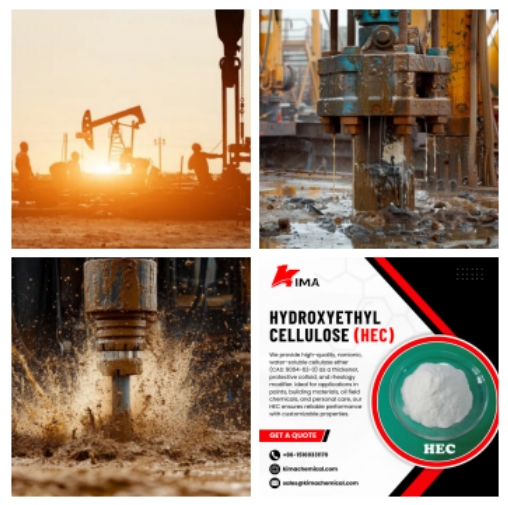Hydroxyethyl Cellulose (HEC) is a non-ionic water-soluble cellulose ether that plays an important role in oil drilling projects, especially in the preparation of drilling fluids and completion fluids.
1. Basic properties of hydroxyethyl cellulose
Hydroxyethyl cellulose is a water-soluble polymer made from natural cellulose by reacting with ethylene oxide after alkali treatment. It appears as white or light yellow odorless powder or granules, which is easily soluble in cold and hot water to form a transparent viscous solution. The solution of HEC has good water retention, suspension, film-forming and colloid protection, and exhibits typical pseudoplastic rheological characteristics.
The solubility and viscosity of HEC are greatly affected by the degree of substitution (DS) and the molar substitution (MS) of the substituent. In oil drilling applications, HEC of different viscosity grades is often used to meet the needs of different well conditions.

2. Mechanism of HEC in oil drilling
During the drilling process, drilling fluid (mud) is used to cool the drill bit, remove cuttings, stabilize the well wall and control formation pressure. As an important additive to drilling fluid, HEC mainly works through the following mechanisms:
Viscosity-enhancing effect: HEC can significantly increase the viscosity of drilling fluid, thereby enhancing the ability to carry cuttings, which is especially important in vertical or high-angle wells.
Rheological control: HEC gives drilling fluid excellent shear-thinning properties (pseudoplasticity), which facilitates the stability and efficiency of the circulation system during drilling.
Water retention and lubrication effect Matoho: HEC has a strong water retention capacity, which helps prevent the water in the mud from evaporating too quickly under high temperature and high pressure, and improves lubrication performance and reduces friction between the drill bit and the well wall.
Filtration control: HEC can form a dense filter cake, reduce the penetration of filtrate in the drilling fluid into the formation, thereby protecting the oil and gas layer from contamination.
3. Specific application of HEC in oil drilling
Application in drilling fluid system
HEC shows good viscosity increasing and rheological control performance in freshwater, salt water and seawater drilling fluids. Its aqueous solution can maintain stable viscosity and still maintain certain performance in saline environment, which is suitable for various complex formations.
Application in completion fluid and operating fluid
HEC is mainly used to suspend and carry bridge plug materials such as barite and bentonite in completion fluid. Its good adhesion and stability help to improve the cleanliness of the wellbore and prevent the wellbore from collapsing.

Application in fracturing fluid (auxiliary material)
Although HEC is not the main thickener of fracturing fluid, HEC can be used as an auxiliary agent in some medium and low pressure formation fracturing operations to provide certain suspension and sand carrying capacity.
Environmentally friendly mud system
HEC is derived from natural cellulose, is easily biodegradable, and is a green and environmentally friendly material. Today, when green drilling technology is increasingly valued, its environmental protection characteristics are particularly important.
4. Advantages and challenges of HEC
Advantages:
Good solubility and stability;
Excellent rheological properties;
Good salt and alkali resistance;
Non-toxic and harmless, environmentally friendly.
Challenges:
Limited high temperature resistance, generally suitable for medium temperature wells;
Incompatible with strong oxidants or strong acid and alkali environments;
Relatively high cost, especially for high viscosity grade products.
HEC, as a water-soluble polymer with excellent performance, has broad application prospects in the field of oil drilling. It can not only improve the performance of drilling fluids and improve drilling efficiency, but also protect oil and gas formations to a certain extent, which meets the current needs of improving quality, efficiency and green development in the oil industry. In the future, with the advancement of technology, the application of HEC in high temperature and high pressure wells and complex formations is expected to be further expanded, and its compounding technology and performance modification will also become a research hotspot, providing strong support for the development of oil drilling technology.
 English
English 日本語
日本語 français
français Deutsch
Deutsch Español
Español italiano
italiano русский
русский português
português العربية
العربية Türkçe
Türkçe Nederland
Nederland





